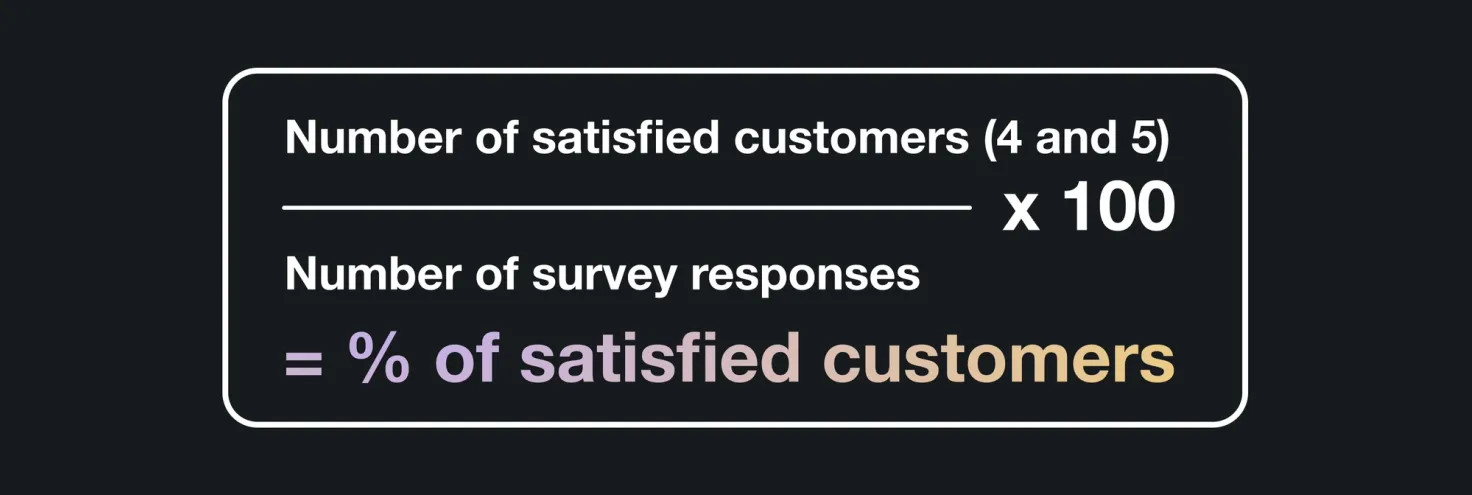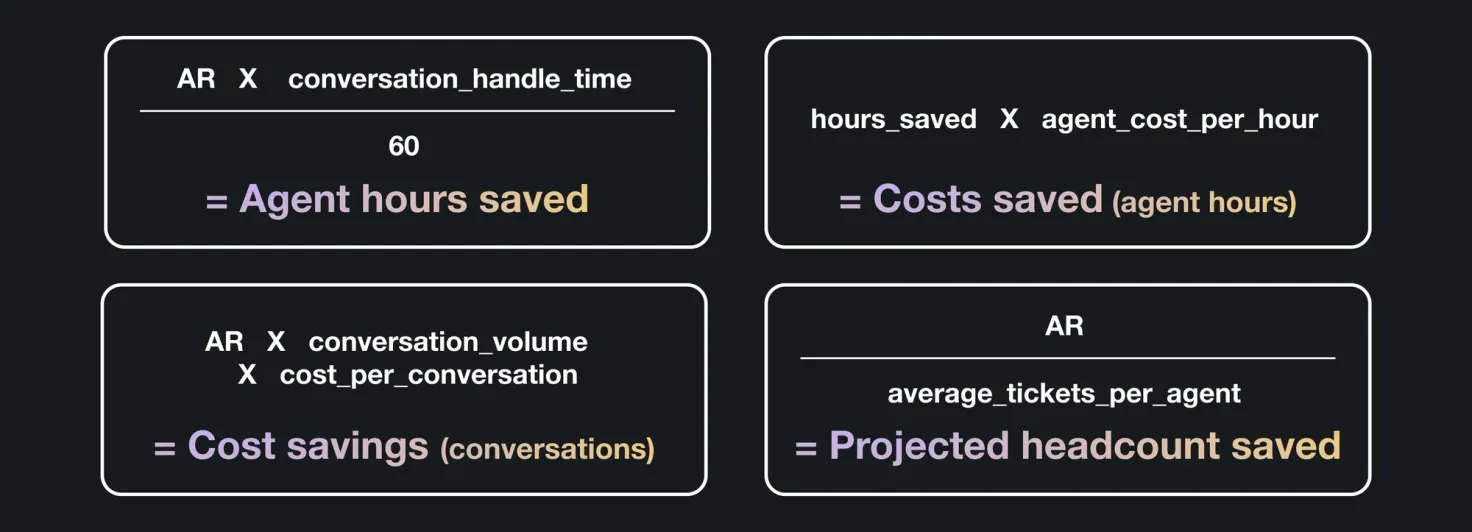
how to prioritize tech stack investments for AI customer service
Learn how to invest in systems that boost AI performance, CSAT, and ROI, without bloating your customer service tech stack.
Learn More

For seasoned customer service experts, CSAT (Customer Satisfaction Score) is a tried-and-true metric for evaluating user satisfaction in customer support. If you’re new to the industry, customer service metrics like CSAT, Net Promoter Score (NPS) and Customer Effort Score (CES), will likely continue to dominate customer service reports. But their relevance is waning — unless you learn when (and when not) to use them in an age where Automated Resolution is king.
Learn how to use CSAT and other customer satisfaction metrics more strategically to grow your customer service goals and prepare for an AI-first world.
CSAT, or customer satisfaction score, is a metric customer service teams use to measure how satisfied customers are with their company’s products or services. Measured through customer feedback, it’s expressed as a percentage — 0% being a terrible experience and 100% being an exceptional customer experience.
CSAT provides a snapshot of customer satisfaction at a given moment and can be calculated using a simple formula:

CSAT surveys typically feature a single question: "How satisfied were you with your experience?" Responses are graded on a predefined scale, often ranging from 1 to 10, 10 being a happy, satisfied user.
Businesses calculate their CSAT score by taking the average of survey responses. For example, if a particular support channel consistently receives lower CSAT scores, there may be issues with response time, agent knowledge, or communication skills.
CSAT surveys are a straightforward and efficient way to gather valuable customer feedback. Their simplicity makes them easy to use — just one question with a rating scale. This ensures high response rates. CSAT surveys can be deployed at various touch points across the customer journey to provide insights at every stage.
CSAT generates user-friendly data that is simple to analyze. Tracking scores over time highlights areas for improving customer experience. Widely adopted, CSAT scores can benchmark against industry standards.
It’s important to consider response bias when analyzing CSAT scores. Not all feedback may accurately reflect reality. Think of it like a funhouse mirror — not all reflections are true representations.
Response bias is an important consideration when looking at CSAT scores. This bias can lead to an imbalance in the types of responses received, ultimately influencing the overall satisfaction results.
This bias can skew the overall CSAT score, giving a potentially distorted representation of the true satisfaction levels. To mitigate response bias, companies should survey a variety of customers. Aim for a diverse and representative sample of customers by implementing strategies like random sampling — this ensures all customers have an equal chance of being included in the survey.
Customer satisfaction surveys can give helpful information, but biases from emotions, culture, and values of respondents may affect the results.. Accounting for these biases is key to accurately interpreting CSAT survey findings.
The simplicity of CSAT surveys restricts the depth of feedback gathered, offering a superficial grasp of customer satisfaction. These straightforward surveys lack nuanced customer perceptions and may miss underlying problems.
CSAT is the primary way to measure customer satisfaction, but NPS, CES, and Containment Rate also provide important insights into how customers view your organization. Each of these metrics offer valuable information about customer perception.
Net Promoter Score (NPS) measures customer loyalty over time rather than satisfaction with individual transactions. It categorizes respondents as detractors, passives, or promoters based on their likelihood of recommending a brand. This segmentation provides a comprehensive understanding of long-term customer sentiment.
Customer Effort Score (CES) measures the ease or difficulty customers encounter when completing various tasks with your business. CES surveys typically assess the simplicity of interactions, such as placing orders online, providing valuable insights into customer experience.
Containment Rate: is the percent of conversations that did not result in a handoff to human support. If your containment rate is 100%, this may mean handoffs are disabled for your bot.
To sum it up: NPS measures loyalty, CES gauges effort, and CSAT complements them by assessing satisfaction at various touchpoints. CSAT offers flexibility to evaluate specific interactions, contrasting NPS and CES's broader views. Each metric provides a unique perspective on customer sentiment — CSAT focuses on satisfaction at specific customer service moments, NPS evaluates loyalty over a period of time, and CES assesses the ease of customer interactions.
While CSAT surveys are invaluable for assessing customer satisfaction, there are scenarios where alternative approaches may be more appropriate. Let’s take a look.
Complex Feedback: Sometimes, a simple thumbs-up or thumbs-down just won’t cut it. For more in-depth insights into specific aspects of your product or service, metrics such as Net Promoter Score (NPS) or Customer Effort Score (CES) may offer greater granularity than CSAT.
Limited Response Options: CSAT surveys typically provide a predefined scale, which may not capture nuanced feedback. Utilize open-ended questions or qualitative research methods for more comprehensive insights.
Overuse: Excessive CSAT surveys can lead to survey fatigue and decreased response rates. It's imperative to create a balance and deploy surveys reasonably to maintain engagement.
Inappropriate Timing: Sending CSAT surveys immediately after a negative experience may yield skewed results. Allow time for emotions to settle before soliciting feedback to ensure accuracy.
CSAT surveys are a highly valuable tool though it's crucial to complement them with other metrics and deploy them strategically to gain a comprehensive understanding of customer feedback.
The emergence of Automated Resolution (AR) signals a transformative shift in customer service, prioritizing relevance, accuracy, and safety in fully automated interactions, marking the dawn of AI-first customer service.
The rise of Automated Resolution ushers in a new era for evaluating AI agent performance . Businesses can improve their customer service satisfaction (and their automation performance) by monitoring key metrics like Automated Resolution Rate (ARR%) across conversations. Companies will gain valuable insights into how to make their automation more effective, resulting in happier customers.
Automated Resolution Rate (ARR%): The Automated Resolution Rate measures the percentage of customer inquiries or issues that are successfully resolved through automated interactions without the need for human intervention. A high ARR% indicates the effectiveness of AR in handling customer queries autonomously.
When measuring Automated Resolution, it's natural to observe a lower count compared to your containment rate. This discrepancy is typical. Containment measures the number of conversations that didn’t need human intervention, regardless of whether the issue was resolved or not.
AR only looks at successful conversations. This provides a more precise evaluation of your AI's effectiveness by analyzing the outcomes and substance of these interactions. AR offers deeper insights, leveraging machine learning algorithms to determine if customers received the necessary assistance.
Automated Resolution insights dig deeper. They help companies understand why conversations are resolved or not resolved, improving performance by identifying gaps. Containment is an industry standard metric for customer service automation, but Automated Resolution gives a more complete view of an AI agent's performance.
If your existing AI solution doesn’t offer Automated Resolution metrics, you can still manually evaluate it using the following approach:
Once you have an understanding of your Automated Resolution Rate, you can showcase the impact of AI on the bottom line of your customer support organization.

AR marks a fundamental change in how customer service is evaluated. CSAT, NPS, CES, and other methods still have value in assessing the overall customer experience. Whatever approach your organization chooses, your metrics must be scalable, quantifiable, and enable concrete improvements.
By adopting automated solutions, businesses can boost operational efficiency and provide smooth, satisfying customer experiences, strengthening their competitive position in the digital age. The right AI-agent will effectively gauge valuable customer interactions and translate them into tangible outcomes. It should also easily distribute satisfaction surveys on a large scale by integrating them into natural, chat-based conversations, which increases response rates.
In the ever-evolving landscape of customer service, zeroing in on when and when not to use CSAT and other satisfaction metrics is pivotal for staying ahead of the curve, ensuring your strategies align with the changing expectations of customers, and ultimately, achieving lasting customer success in an AI-driven era.
There's a growing need to understand how agent-first metrics are evolving in a AI-first world. Get the expert guide.
Get the report